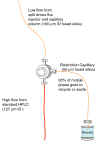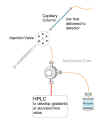Build Your Own Capillary HPLC From A Standard Flow HPLC |
|
|
Introduction: Any standard HPLC can be adapted to use capillary HPLC columns. We have successfully converted HP 1090™ and HP 1100™ liquid chromatographs into fully automated capillary HPLCs. We have had difficulty automating the Waters Alliance™ HPLC. However, every HPLC is capable of driving capillary columns in a manual fashion using the principles described in this tutorial. Automation (integration of the autosampler) of every HPLC system depends on the dead volume associated with your particular autosampler and associated components. The primary principles used in the conversion are flow rate reduction and elimination of dead volume. Capillary columns allow lower sample consumption and the ability to analyze and isolate rare compounds of interest. One of the "key" advantages provided by capillary HPLC is that peak analyte concentrations can be as much as 100 fold higher than that seen with conventional columns. This single fact makes the use of capillary columns preferential to the mass spectrometrist since the mass spectrometer is largely a concentration dependent detector. Also, preparative work up to and even exceeding 1 nmol can be carried out efficiently on larger capillary columns. Absorptive losses are held to a minimum when a 1 nmol peak is collected in 5 µL rather than in 400 µL which is a common collection volume for standard columns. This tutorial will concentrate on the use of 320 micron (µM) ID capillary columns, however the principles described here can be applied to the use of smaller diameter columns. We have adapted 150 µM ID capillary columns for automated use with the HP 1090™ HPLC with very little trouble. With a few tricks 75 µM ID capillary columns may also be used but thing gets a bit trickier with flow rates below 1µL/min. If you are going to use columns with internal diameters smaller than 320 µM one can imagine that attention to dead volume issues become critical. Capillary columns with internal diameters of 320 microns (0.32 mm) use flow rates from 3 to 8 µL per minute. Most modern HPLCs can develop organic gradients at flow rates as low as 200 µL/min. In this tutorial we will discuss the basic principle of flow rate reduction using a flow splitting tee, describe a simple capillary system, discuss plumbing issues, describe the conversion of a common standard HPLC into a fully integrated automated capillary HPLC, describe common capillary UV flow cells and discuss several applications of a capillary HPLC. Primarily this tutorial attempts to demonstrate how one can adapt any HPLC to use capillary reverse phase HPLC columns.
Andrew Guzzetta |
|
|
. |
|
|
TOC Introduction Glossary Simple System Automation UV Detection Plumbing The Truth About Splitting Applications Order Components References |

|
| HP1090 and 1100 are trademarks of Agilent Corporation and Alliance is a trademark of Waters Corpoartion | |
| - | |
|
home
| disclaimer |
|

